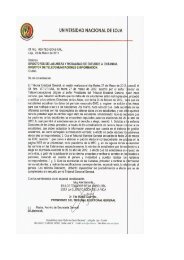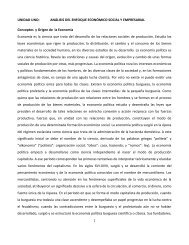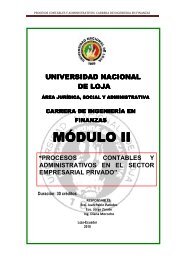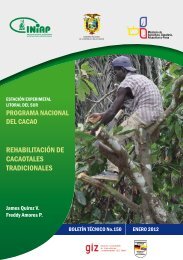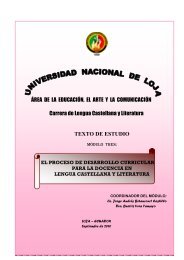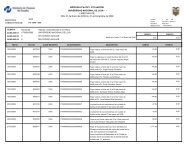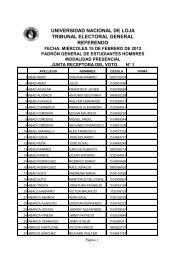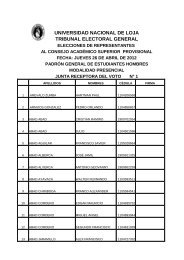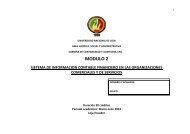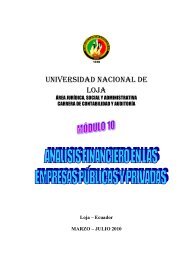module 5 planning of the english language teaching-learning process
module 5 planning of the english language teaching-learning process
module 5 planning of the english language teaching-learning process
You also want an ePaper? Increase the reach of your titles
YUMPU automatically turns print PDFs into web optimized ePapers that Google loves.
UNIVERSIDAD NACIONAL DE LOJA<br />
Área de la Educación el Arte y la Comunicación<br />
English Language Career<br />
activities that will promote progression and some information about <strong>the</strong> amount<br />
<strong>of</strong> time needed to cover <strong>the</strong> objectives (whe<strong>the</strong>r in blocked periods or regular<br />
lessons over a period <strong>of</strong> weeks).<br />
Short term plan, also called lesson-or weekly plans (Micro-Planning)<br />
There are different ways <strong>of</strong> describing short-term plans. For <strong>the</strong> purpose <strong>of</strong><br />
<strong>the</strong>se materials, a short-term plan is a set <strong>of</strong> activities for a week, a day, or a<br />
lesson.<br />
Short-term <strong>planning</strong> is based on <strong>the</strong> needs <strong>of</strong> individual schools and teachers.<br />
Teachers <strong>of</strong>ten use short-term plans to think through <strong>the</strong> structure and content<br />
<strong>of</strong> a lesson and to note information such as key questions, resources,<br />
differentiation and assessment opportunities, especially where this is not<br />
already included in <strong>the</strong> medium-term plan.<br />
Many teachers use lesson plans selectively, for particular activities or subjects,<br />
ra<strong>the</strong>r than for every lesson. Experienced teachers <strong>of</strong>ten work direct from a<br />
medium-term plan and make notes as and when needed to support <strong>the</strong>ir<br />
<strong>teaching</strong>.<br />
LESSON PLANNING AND USE OR RESOURCES FOR<br />
LANGUAGE TEACHING<br />
Planning and preparing a lesson or sequence <strong>of</strong><br />
lessons<br />
Identifying and selecting aims<br />
How do we identify and select aims?<br />
Aims are what we want learners to learn or be able to do at <strong>the</strong> end <strong>of</strong> a lesson,<br />
a sequence (i.e. a series) <strong>of</strong> lessons or a whole course. Aims may focus, for<br />
example, on a function or a grammatical structure, on <strong>the</strong> vocabulary <strong>of</strong> a<br />
particular topic or on developing a <strong>language</strong> skill. Aims, especially for younger<br />
learners, may not always focus on particular areas <strong>of</strong> <strong>language</strong>. The aim <strong>of</strong> a<br />
lesson may also be listening to a story for pleasure or encouraging a positive<br />
attitude towards <strong>the</strong> foreign <strong>language</strong>. To identify and select <strong>the</strong> most<br />
appropriate aims, we need to ask ourselves two questions:<br />
[Escribir texto] Página 45



